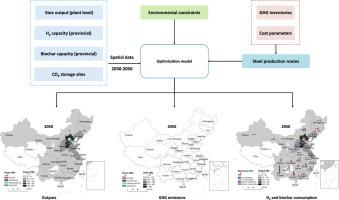2030-2050年中国钢铁工业脱碳的空间转型路径
IF 10.9
1区 环境科学与生态学
Q1 ENGINEERING, ENVIRONMENTAL
引用次数: 0
摘要
中国钢铁行业必须在2060年前实现碳中和,理想情况下是在2050年前实现。目前的脱碳路线图忽略了资源地理分布对低碳技术(基于废料、基于h2和生物质的组合CO2捕集与封存[BECCS])的影响。本文采用空间明确的方法,结合各省可利用的生物质/氢气、钢铁厂选址和二氧化碳储存地点,结合技术经济选择模型,探索中国钢铁行业(2030-2050)的碳中和路径。结果表明,建模框架确定了通过上述技术的平衡混合实现全国碳中和的最具成本效益的解决方案,其中BECCS至关重要。选择的混合取决于各省氢气和生物炭的可用性和价格水平。一个省的负温室气体排放可以抵消其他省昂贵的缓解办法。我们的研究结果强调,为了实现全国碳中和和应对资源挑战,需要根据地区资源可用性,为低碳钢工厂制定各省具体的优先事项。本文章由计算机程序翻译,如有差异,请以英文原文为准。

Spatially explicit transition pathways for decarbonizing China’s steel industry during 2030–2050
China’s steel industry has to achieve carbon-neutral by 2060, ideally by 2050. Current decarbonization roadmaps overlook the impact of resource geographical distribution on low-carbon technologies (scrap-based, H2-based and biomass combined CO2 capture and storage [BECCS]). Here, we used a spatially explicit approach incorporating provincial available biomass/H2, steel plant locations and CO2 storage sites combined a techno-economic selection model to explore carbon-neutral pathways for China’s steel industry (2030–2050). Results indicate that the modelling framework identifies the most cost-effective solutions for achieving nationwide carbon neutrality through a balanced mixture of above technologies, with BECCS being crucial. The mixture of options depend on the provincial availability and price levels of H2 and biochar. Negative GHG emissions in one province can offset costly mitigation options in other provinces. Our results highlight the need for province-specific priorities for low-carbon steel plants based on regional resource availabilities to achieve national carbon neutrality and address resource challenges.
求助全文
通过发布文献求助,成功后即可免费获取论文全文。
去求助
来源期刊

Resources Conservation and Recycling
环境科学-工程:环境
CiteScore
22.90
自引率
6.10%
发文量
625
审稿时长
23 days
期刊介绍:
The journal Resources, Conservation & Recycling welcomes contributions from research, which consider sustainable management and conservation of resources. The journal prioritizes understanding the transformation processes crucial for transitioning toward more sustainable production and consumption systems. It highlights technological, economic, institutional, and policy aspects related to specific resource management practices such as conservation, recycling, and resource substitution, as well as broader strategies like improving resource productivity and restructuring production and consumption patterns.
Contributions may address regional, national, or international scales and can range from individual resources or technologies to entire sectors or systems. Authors are encouraged to explore scientific and methodological issues alongside practical, environmental, and economic implications. However, manuscripts focusing solely on laboratory experiments without discussing their broader implications will not be considered for publication in the journal.
 求助内容:
求助内容: 应助结果提醒方式:
应助结果提醒方式:


